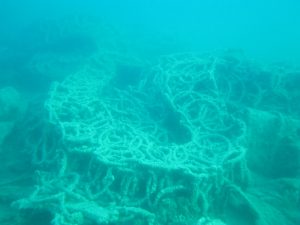The wreck of “M/V Vettor Pisani” (+1942) off Lepeda beach
The wreck of “M/V Vettor Pisani” (+1942) off Lepeda beach in Kefalonia
On 24 July 1942, the Italian motor vessel “M/V Vettor Pisani” (built in 1939, tonnage 6,339, length 137.5m) departed from Taranto bound for Tobruk and sailing off Cape Gherogombo, the southwestern point of Kefalonia as part of a convoy, accompanied by torpedo boats “Antares” and “Calliope” and escort destroyer “Orsa”, was attacked by 6 British aircraft position 10 miles 240 degrees from said Cape 38 05N, 20 12E. See the history of the air raid here: http://aviationarchaeology.gr/?p=2249
There was an explosion, smoke and red flame.. the hit was at hold number 2 where fuel was transported in barrels and a violent fire broke out in the bow section. The severely damaged ship was towed by the “Orsa” connected by the stern, against the wind to prevent the fire from spreading to the stern section that had survived unscathed so far. Despite the efforts it was impossible to reach Argostoli harbor and in order to avoid sinking it ran aground in the shallows on the western shores of the Argostoli Gulf, specifically 1 km south of Lixouri town (pic. 1,2). It stayed ablaze until next day while a new airstrike with bombs and strafing caused even more damage. On 27 July its recovery and repair was deemed pointless and declared total loss.
Later that year, while the ship was stranded and in order to recover as much of the cargo as possible, dynamite was used to retrieve whatever could be salvaged. In photos taken from the land but also in aerial photographs of the year 1945 (Hellenic Geographical Service) the ship appears stranded (the aerial photograph also confirms the length of the ship), at a distance of approx. 300m from the coast (at the nearest point), with the bow facing southeast towards the entrance of the Gulf (pic. 3,4).
At this location the “M/V Vettor Pisani” remained until 1951 when it was refloated and towed to Italy where it was repaired to travel the seas again (fig. 5,6). Despite being destroyed by torpedoes, bombs, fire and dynamite and the long abandonment, the ship was modern enough and in relatively good condition to be left to rot, but also stranded in shallow water that could facilitate basic repairs to take it to the shipyard. Finally, after 20 years of service the ship retired in 1971 and was scraped.
The shipwreck today
What can be found today are scattered debris at a depth of only 10m, including a large number of metal barrels, batteries, parts of motorcycles, etc. all covered by sediment agglomerates. However, the most remarkable and perhaps useful for the confirmation of their destination and consequently of their origin, is a steel chain net composed of interconnected rings (pic. 7,8).
According to the “Net and boom defenses, Ordnance pamphlet 636A, 24 June 1944, U.S. Navy”, this configuration is typical for torpedo net (Type“T”net, Torpedo) (pic. 9), which were either installed in the port (suspended on floats, in a continuous barrier or partial barriers), or directly on a ship (suspended on horizontal booms, around the perimeter of the boat). The principle of operation is the following: The small cross section of a torpedo combined with its high speed exerts momentarily concentrated force on a single point, so each ring must be relatively small in diameter (about 40 cm) in order to intercept the object trying to penetrate but also attain a strong connection with the rest around it so the energy of the torpedo can be absorbed by a group of links (hence the lower end of the net was free to facilitate rotation around the horizontal axis and to diffuse the energy more efficiently). Another element of its particular usefulness was the anti-torpedo net’s ability to provide protection against aerial torpedoes, while the anti-submarine net only prevented the entry of such into an anchorage.
The above remarks make sense if we consider the destination of the ship that was Tobruk with its large natural harbour, which had just been occupied by Rommel (Deutsches Afrikakorps – DAK) a mere month ago. He was also already preparing a new offensive east into Egypt therefore this would serve him as an advanced resupply port but at the same time in close proximity to enemy naval and air forces. The Italians also had the recent traumatic experience from the raid on Taranto in November 1940, when the shortage of anti-torpedo nets (they were only 4 km installed instead of the 13 km required) led to severe damages to battleships from British aerial torpedoes.
Tilemachos Beriatos
CMAS 3 star Diver, PSS Technical Diver
Research 2012-2017
Pictures:

MV Vettor Pisani on flames
1. Vettor Pisani on flames (“Navi mercantili perdute”, Rolando Notarangelo e Gian Paolo Pagano, USMM)

Delfino in support of Vettor Pisani
2. The vessel Delfino in support of Vettor Pisani (Pietro Berti, naviearmatori.net)

Vettor Pisani grounded off the coast, Lixuri Kefalonia
3. Vettor Pisani grounded off the coast, Kefalonia (photograph Mike Georgatos)

Vettor Pisani grounded off the coast, Kefalonia aerial photograph
4. Vettor Pisani grounded off the coast, Kefalonia (aerial photographs 1945, Hellenic Geographical Service)

Vettor Pisani during repair in Monfalcone 1951
5. Vettor Pisani during repair in Monfalcone 1951 (Giorgio Parodi, naviearmatori.net)

Vettor Pisani after repair 1951
6. Vettor Pisani after repair 1951 (Ferruzzi-Venezia via Giuseppe Boato)

Metal barrels and wheels at Vettor Pisani debris field
7. Metal barrels and wheels (dive at the debris field 8-2010, Tilemachos Beriatos)

Metal torpedo net at Vettor Pisani debris field
8. Metal torpedo net (dive at the debris field 8-2010, Tilemachos Beriatos)

Rigging torpedo net (US Navy)
9. Rigging torpedo net (Bureau of Ordnance, US Navy)











Leave a Reply
Want to join the discussion?Feel free to contribute!